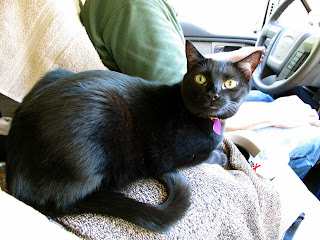 |
| Not a lighthouse in our book |
The two days we camped in the Fundy National Park were sunny, bright and brisk, perfect for hiking and taking in coastal views of the Bay of Fundy as the tides fluctuated by about 30 feet. The first day we decided to drive along the coast to Cape Enrage where we understood there was a spectacular view and a lighthouse you could tour. The drive there was scenic but when we arrived, there was no tour. The view was pretty much what we had seen from the road, and the “lighthouse” was only a green channel marker housed in a lighthouse-like building. We had paid $4 each and were miffed. “So that’s why it’s called Cape Enrage,” I said. “After you see what you’ve paid for, you’re enraged.” We continued driving farther along the coastline, but decided to forego another highly-touted attraction, Hopewell Rocks, which charges $8.50 a person to walk at low tide among flowerpot rocks.
The next day we drove around the park itself and went on several hikes, each one different: coastal, Acadian forest, marsh/bog.... My favorite was Dickson Falls trail with a boardwalk that followed a mossy stream part of the way. Most of the park has been logged. The streams were dammed and polluted by the logging, which destroyed the salmon fisheries. The fishermen complained, but logging was the biggest industry at the time. 60 years ago the logging stopped and since then the forests and streams have been recovering. Fisheries restoration is also underway.
 When we left the park the next morning, we stopped at the dumping station to discharge the holding tanks. Another RV pulled up, a woman opened the passenger door and cheerily started asking me where we’ve been and where we were going. They were from Austin, Texas. We chatted until the dumping was done, about 15 or 20 minutes. “We’ll probably see you along the way,” I said. “I hope so,” she said.
When we left the park the next morning, we stopped at the dumping station to discharge the holding tanks. Another RV pulled up, a woman opened the passenger door and cheerily started asking me where we’ve been and where we were going. They were from Austin, Texas. We chatted until the dumping was done, about 15 or 20 minutes. “We’ll probably see you along the way,” I said. “I hope so,” she said.  |
| This fella was hanging out in a drainage pipe. |
We’ve met many friendly Canadian and American campers. One afternoon I was doing laundry. (Most campgrounds have a laundry room.) A man was sitting in the adjacent lounge, reading a book. I sat down and started talking with him. He lived inland, a couple of hours away. He and his wife wanted to be near the ocean and decided to go camping for 3 weeks. “What have you been doing all that time?” I asked. “Mostly sculpting,” he said. “Also taking long walks on the beach with the dog.” We talked until our laundry was done, and later I met his wife and dog. (He was sculpting masks out of some kind of plastic, I think.) We met a nice couple from Alberta who lent us a 30-amp power extension cord at one campground when our cord just couldn’t reach. We met a friendly couple from Maryland in front of the caves at low tide. Just this morning another camper wandered over as we were getting ready to leave. He was a retired trucker from Prince Edward Island. He had driven all over the U.S. and Canada and had a wealth of information that he was only too eager to share. He did divulge some of his hard-earned knowledge, but unfortunately, we had to leave. Meeting all kinds of friendly, interesting fellow travelers has been one of the delightful commonalities land cruising has with ocean cruising.
















